GMC SAVANA 1997 Owners Manual
Manufacturer: GMC, Model Year: 1997, Model line: SAVANA, Model: GMC SAVANA 1997Pages: 388, PDF Size: 20.17 MB
Page 301 of 388
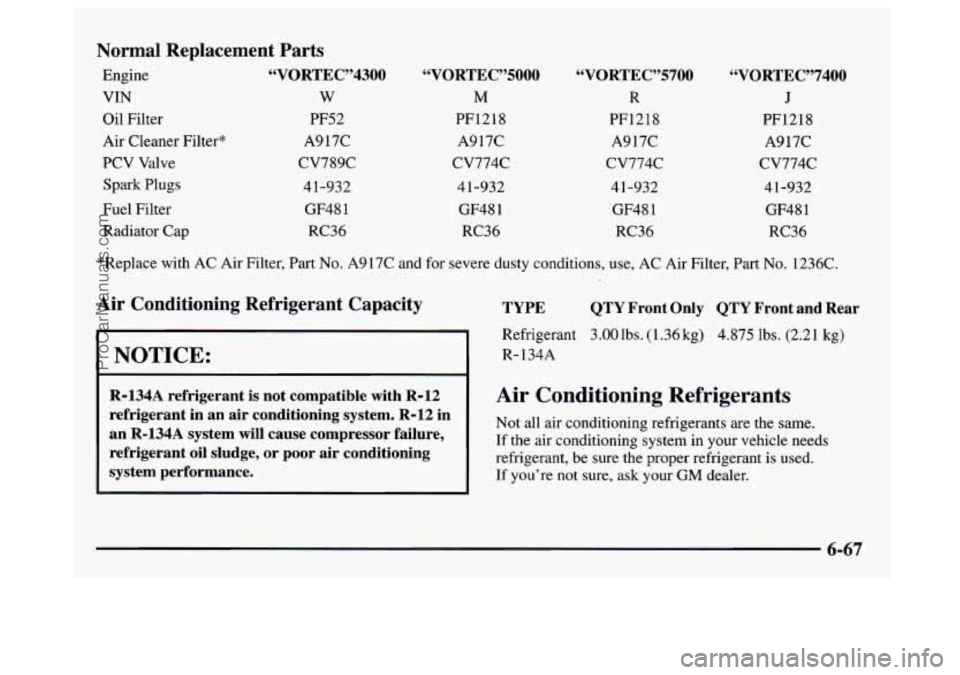
Normal Replacement Parts
Engine “VORTEC”4300 “VORTEC”5000 “VORTEC”5700 “VORTEC”\
7400
VIN w M R J
Oil Filter PF52 PF1218 PF1218 PF1218
Air Cleaner Filter* A917C A917C A917C A917C
PCV Valve CV789C cv774c cv774c cv774c
Spark Plugs 41-932 4 1-932 41-932 4 1-932
Fuel Filter GF48
1 GF48 1 GF48 1 GF48 1
Radiator Cap RC36 RC36 RC36 RC36
*Replace with
AC Air Filter, Part No. A917C and for severe dusty conditions, use, AC Air Filter, Part No. 1236C.
Air Conditioning Refrigerant Capacity
I NOTICE:
~~
R-134A refrigerant is not compatible with R-12
refrigerant in an air conditioning system. R-12 in
an R-134A system
will cause compressor failure,
refrigerant oil sludge,
or poor air conditioning
system performance. TYPE
QTY Front Only QTY Front and Rear
Refrigerant 3.00 lbs. (1.36 kg) 4.875 lbs. (2.21 kg)
R- 134A
Air Conditioning Refrigerants
Not all air conditioning refrigerants are the same.
If the air conditioning system in your vehicle needs
refrigerant, be sure the proper refrigerant is used.
If you’re not sure, ask your GM dealer.
6-67
ProCarManuals.com
Page 302 of 388
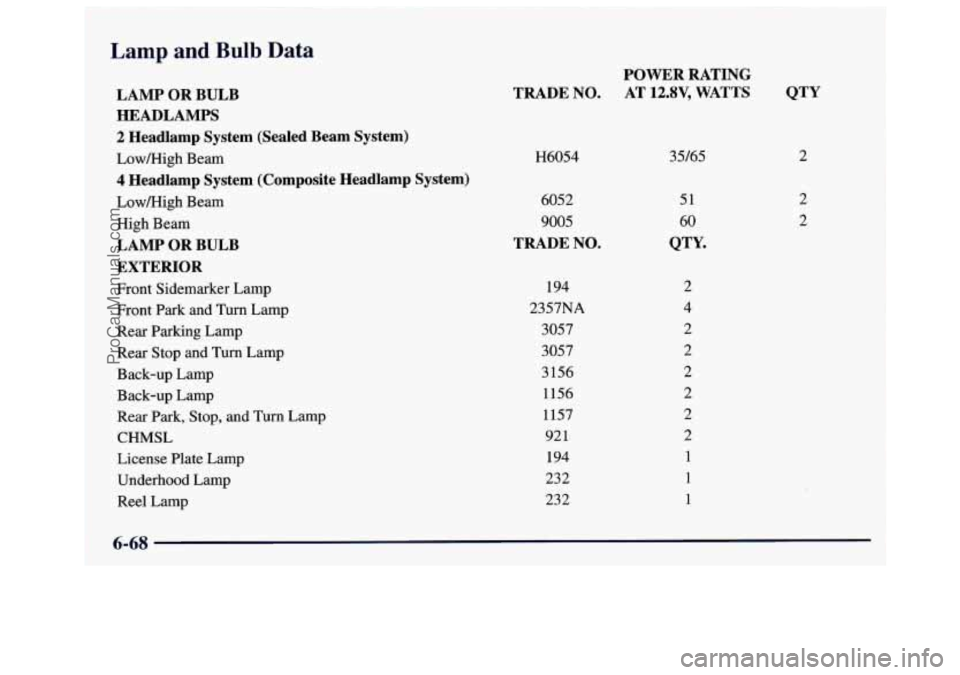
Lamp and Bulb Data
LAMP OR BULB
HEADLAMPS
2 Headlamp System (Sealed Beam System)
Low/High Beam
4 Headlamp System (Composite Headlamp System)
Low/High Beam
High Beam
LAMP OR BULB
EXTERIOR
Front Sidemarker Lamp
Front Park and Turn Lamp
Rear Parking Lamp
Rear Stop and
Turn Lamp
Back-up Lamp
Back-up Lamp
Rear Park, Stop, and
Turn Lamp
CHMSL
License Plate Lamp
Underhood Lamp
Reel Lamp
TRADE NO.
H6054
6052
9005
TRADE NO.
194
2357NA
3057
3057
3156 1156
1157 921
194
232
232
POWER RATING AT
12.8V, WATTS
35/65
51
60
QTY.
2
4
2
2
2
6-68
ProCarManuals.com
Page 303 of 388
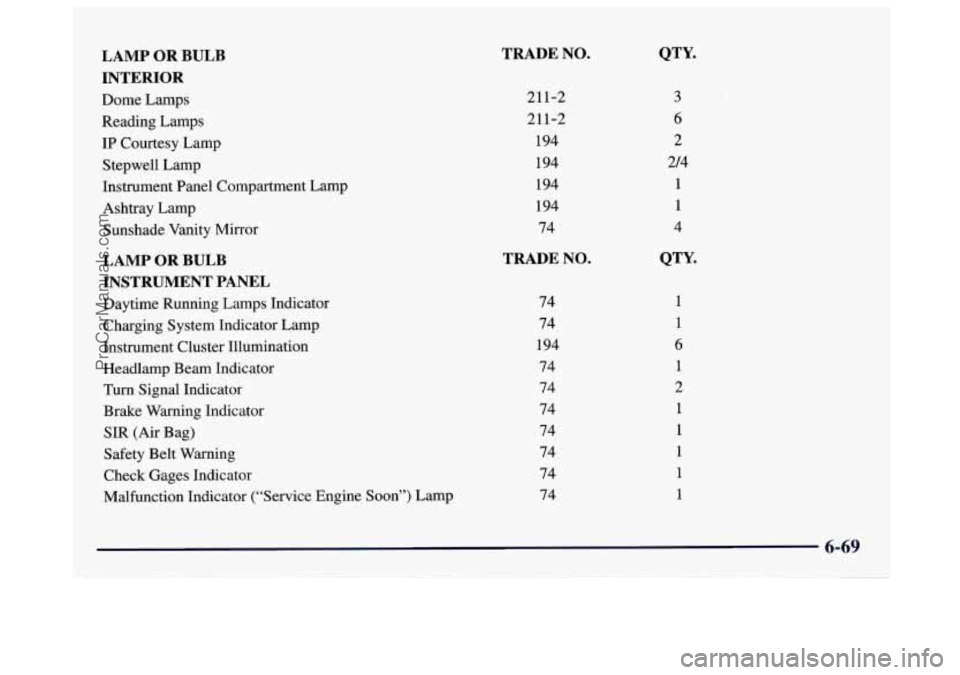
LAMP OR BULB INTERIOR
Dome Lamps
Reading Lamps
IP Courtesy Lamp
Stepwell Lamp
Instrument Panel Compartment Lamp
Ashtray Lamp
Sunshade Vanity Mirror
LAMP OR BULB
INSTRUMENT PANEL
Daytime Running Lamps Indicator
Charging System Indicator Lamp
Instrument Cluster Illumination
Headlamp Beam Indicator
Turn Signal Indicator
Brake Warning Indicator
SIR (Air Bag)
Safety Belt Warning
Check Gages Indicator
Malfunction Indicator (“Service Engine Soon”) Lamp
TRADE NO.
211-2
211-2
194
194
194 194 74
TRADE NO.
74 74
194 74 74
74
74
74
74
74
QTY.
3
6
2
214
1
1
4
QTY.
1 1
6
1
2
1
1
1
1
1
6-69
ProCarManuals.com
Page 304 of 388
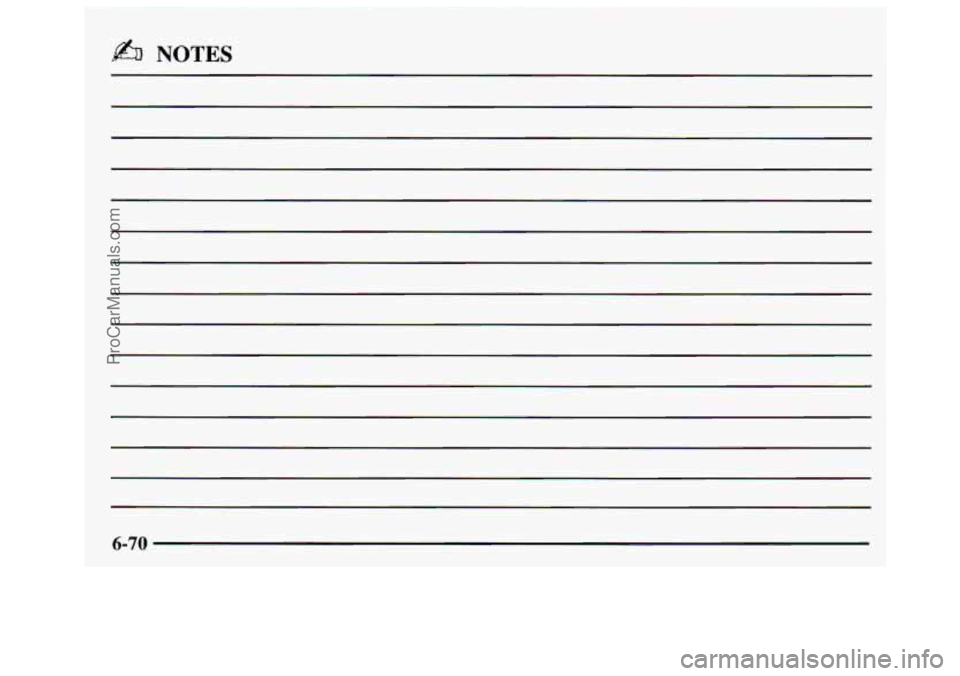
b NOTES
6-70
ProCarManuals.com
Page 305 of 388

Section 7 Maintenance Schedule
This section covers the maintenance required for your vehicle. Your vehicle needs these services to retain its safety,
dependability and emission control performance.
7-2
7-4
7-5
7-5
7-6 Introduction
Part
A: Scheduled Maintenance Services
Short TripKity Definition
Short TripKity Intervals
Long Tripmighway Definition
7-7
7-45
7-49
7-5
1
7-53
Long Trip/Highway Intervals
Part
B: Owner Checks and Services
Part C: Periodic Maintenance Inspections
Part D: Recommended Fluids and Lubricants
Part
E: Maintenance Record
7-1
ProCarManuals.com
Page 306 of 388
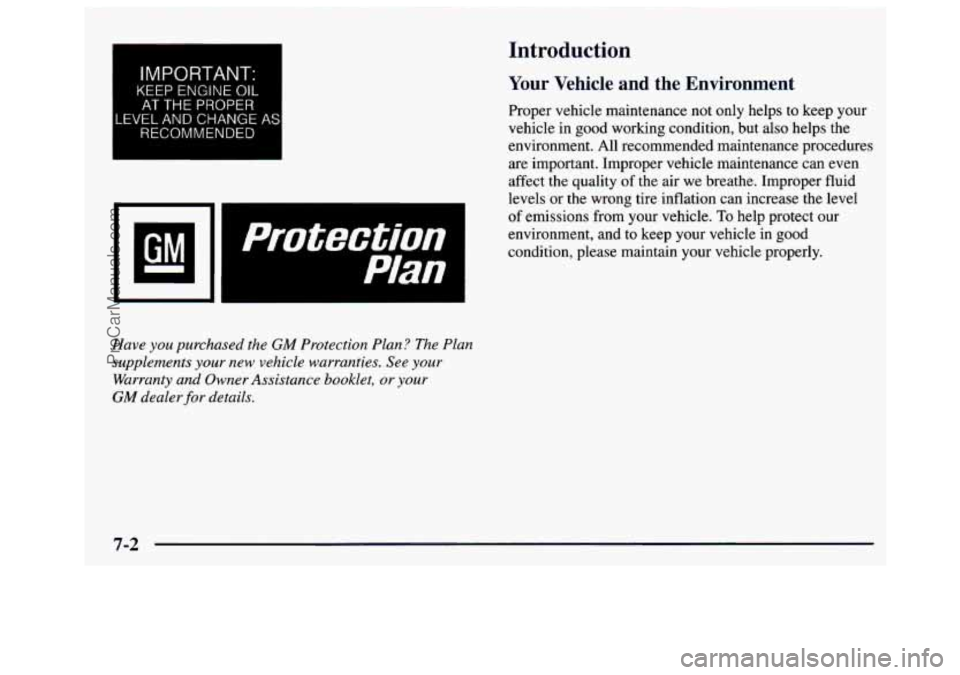
IMPORTANT:
KEEP ENGINE OIL
AT THE PROPER
LEVEL AND CHANGE AS
RECOMMENDED
Have you purchased the GM Protection Plan? The Plan
supplements your new vehicle warranties. See your
Warranty and Owner Assistance booklet,
or your
GM dealer for details.
Introduction
Your Vehicle and the Environment
Proper vehicle maintenance not only helps to keep your
vehicle in good working condition, but also helps the
environment. All recommended maintenance procedures
are important. Improper vehicle maintenance can even
affect the quality
of the air we breathe. Improper fluid
levels
or the wrong tire inflation can increase the level
of emissions from your vehicle. To help protect our
environment, and to keep your vehicle in good
condition, please maintain your vehicle properly.
7-2
ProCarManuals.com
Page 307 of 388
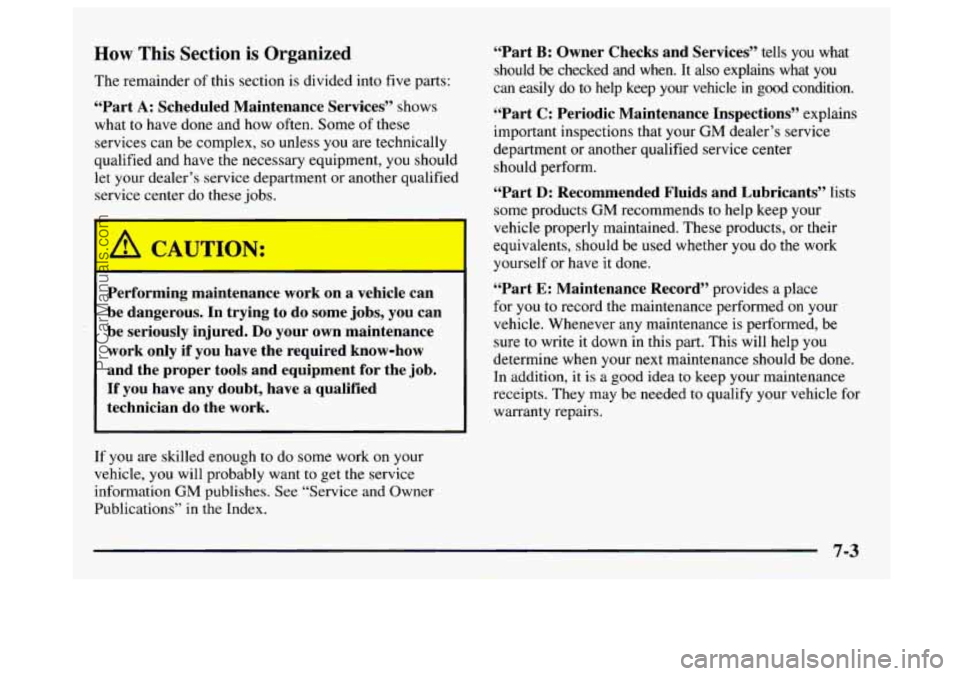
How This Section is Organized
The remainder of this section is divided into five parts:
“Part A: Scheduled Maintenance Services” shows
what to have done and how often. Some
of these
services can be complex,
so unless you are technically
qualified and have the necessary equipment, you should
let your dealer’s service department
or another qualified
service center do these jobs.
Performing maintenance work on a vehicle can
be dangerous.
In trying to do some jobs, you can
be seriously injured.
Do your own maintenance
work only if you have the required know-how
and the proper tools and equipment for the job.
If you have any doubt, have a qualified
technician
do the work.
If you are skilled enough to do some work on your
vehicle,
you will probably want to get the service
information
GM publishes. See “Service and Owner
Publications” in the Index.
“Part B: Owner Checks and Services” tells you what
should be checked and when. It
also explains what you
can easily do to help keep your vehicle in good condition.
“Part C: Periodic Maintenance Inspections” explains
important inspections that your
GM dealer’s service
department or another qualified service center
should perform.
“Part D: Recommended Fluids and Lubricants’’ lists
some products
GM recommends to help keep your
vehicle properly maintained. These products, or their
equivalents, should be used whether
you do the work
yourself or have it done.
“Part E: Maintenance Record” provides a place
for you to record the maintenance performed
on your
vehicle. Whenever any maintenance is performed, be
sure
to write it down in this part. This will help you
determine when your next maintenance should be done.
In addition, it is a good idea to keep your maintenance
receipts. They may be needed to qualify your vehicle for
warranty repairs.
ProCarManuals.com
Page 308 of 388
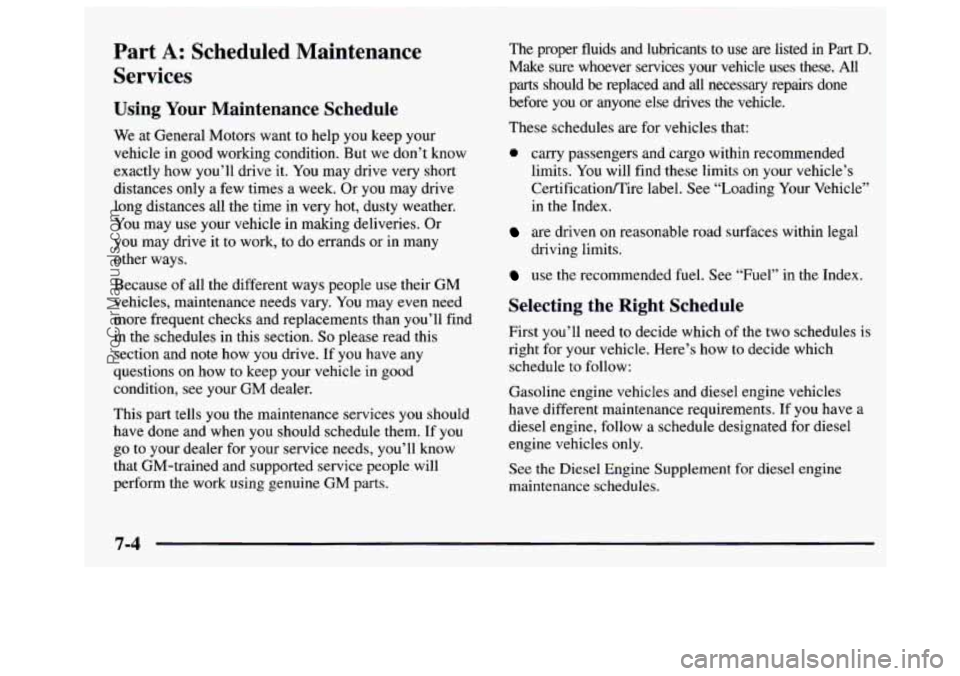
Part A: Scheduled Maintenance
Services
Using Your Maintenance Schedule
We at General Motors want to help you keep your
vehicle in good working condition. But we don’t know
exactly how you’ll drive it.
You may drive very short
distances only
a few times a week. Or you may drive
long distances all the time in very hot, dusty weather.
You may use your vehicle in making deliveries. Or
you may drive it to work, to do ---‘ands or in many
other ways.
Because
of all the different ways people use their GM
vehicles, maintenance needs vary. You may even need
more frequent checks and replacements than you’ll find
in the schedules in this section.
So please read this
section and note how you drive. If you have any
questions on how to keep your vehicle in good
condition, see your GM dealer.
This part tells
you the maintenance services you should
have done and when you should schedule them. If you
go
to your dealer for your service needs, you’ll know
that GM-trained and supported service people will
perform the work using genuine GM parts. The proper fluids and lubricants
to use are listed in Part D.
Make sure whoever services
you vehicle uses these. All
parts should be replaced and all necessary repairs done
before
you or anyone else drives the vehicle.
These schedules are for vehicles that:
0 carry passengers and cargo within recommended
limits. You will find these limits on your vehicle’s
CertificationEire label. See “Loading Your Vehicle’’
in the Index.
are driven on reasonable road surfaces within legal
driving limits.
use the recommended fuel. See “Fuel” in the Index.
Selecting the Right Schedule
First you’ll need to decide which of the two schedules is
right for your vehicle. Here’s how to decide which
schedule to follow:
Gasoline engine vehicles and diesel engine vehicles
have different maintenance requirements. If
you have a
diesel engine, follow a schedule designated for diesel
engine vehicles only.
See the Diesel Engine Supplement for diesel engine
maintenance schedules.
7-4
ProCarManuals.com
Page 309 of 388
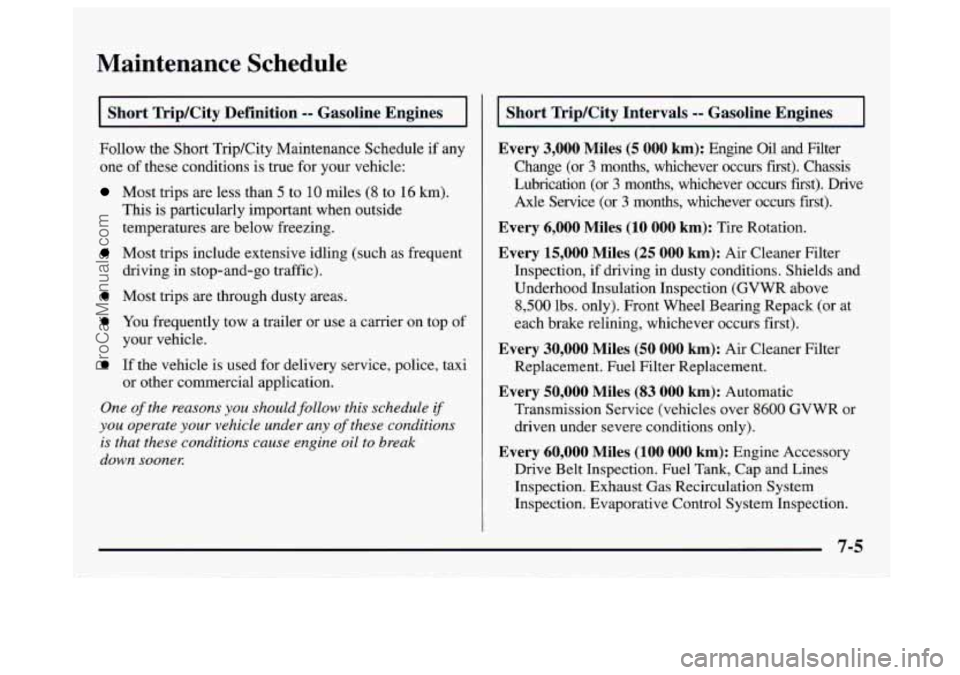
Maintenance Schedule
I Short Trip/City Definition -- Gasoline Engines I
Follow the Short Trip/City Maintenance Schedule if any
one of these conditions
is true for your vehicle:
Most trips are less than 5 to 10 miles (8 to 16 km).
This is particularly important when outside
temperatures are below freezing.
driving in stop-and-go traffic).
Most trips include extensive idling (such as frequent
0 Most trips are through dusty areas.
0 You frequently tow a trailer or use a carrier on top of
your vehicle.
0 If the vehicle is used for delivery service, police, taxi
or other commercial application.
One of the reasons you should follow this schedule if
you operate your vehicle under any of these conditions
is that these conditions cause engine oil to break
down soonex
Short Trip/City Intervals -- Gasoline Engines
Every
3,000 Miles (5 000 km): Engine Oil and Filter
Change (or
3 months, whichever occurs first). Chassis
Lubrication (or
3 months, whichever occurs first). Drive
Axle Service (or
3 months, whichever occurs first).
Every 6,000 Miles (10 000 km): Tire Rotation.
Every 15,000 Miles (25 000 km): Air Cleaner Filter
Inspection, if driving
in dusty conditions. Shields and
Underhood Insulation Inspection
(GVWR above
8,500 lbs. only). Front Wheel Bearing Repack (or at
each brake relining, whichever occurs first).
Every 30,000 Miles (50 000 km): Air Cleaner Filter
Replacement. Fuel Filter Replacement.
Every 50,000 Miles (83 000 km): Automatic
Transmission Service (vehicles over
8600 GVWR or
driven under severe conditions only).
Every 60,000 Miles (100 000 km): Engine Accessory
Drive Belt Inspection. Fuel Tank, Cap and Lines
Inspection. Exhaust Gas Recirculation System
Inspection. Evaporative Control System Inspection.
7-5
ProCarManuals.com
Page 310 of 388
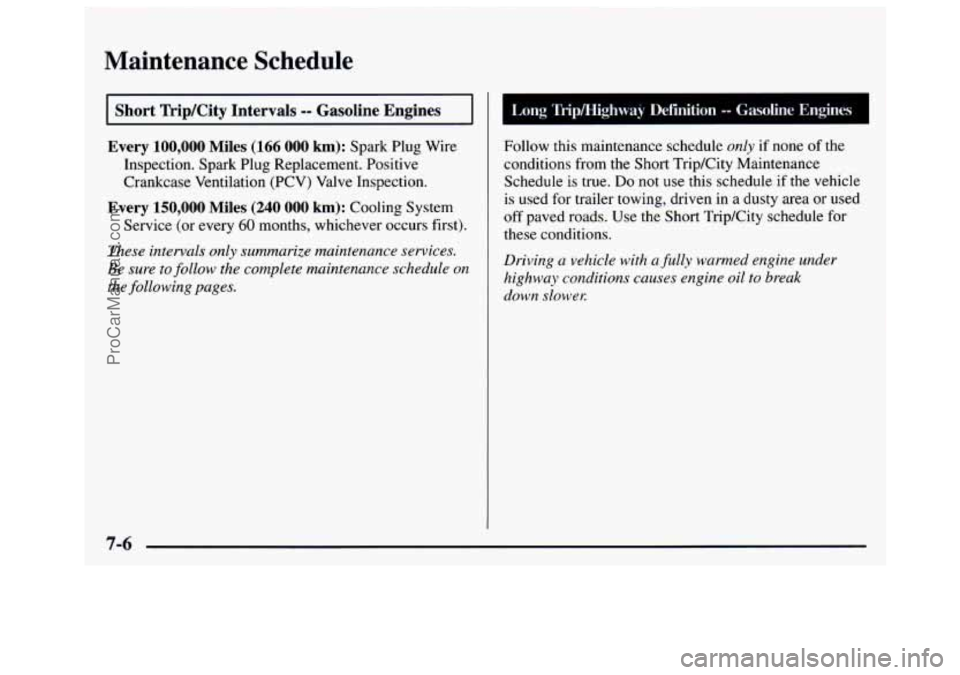
Maintenance Schedule
I
'1 Short TripKity Intervals -- Gasoline Engines
I Every 100,000 Miles (166 000 km): Spark Plug Wire
Inspection. Spark Plug Replacement. Positive
Crankcase Ventilation (PCV) Valve Inspection.
Every 150,000 Miles (240 000 km): Cooling System
Service (or every
60 months, whichever occurs first).
These intervals only summarize maintenance services.
Be sure to
follow the complete maintenance schedule on
the following pages.
Follow this maintenance schedule onZy if none of the
conditions from the Short TripKity Maintenance
Schedule
is true. Do not use this schedule if the vehicle
is used for trailer towing, driven in
a dusty area or used
off paved roads. Use the Short Trip/City schedule for
these conditions.
Driving ci vehicle with n fL1lly warmed engine under
highway conditions causes engine oil to break
down slower.
ProCarManuals.com